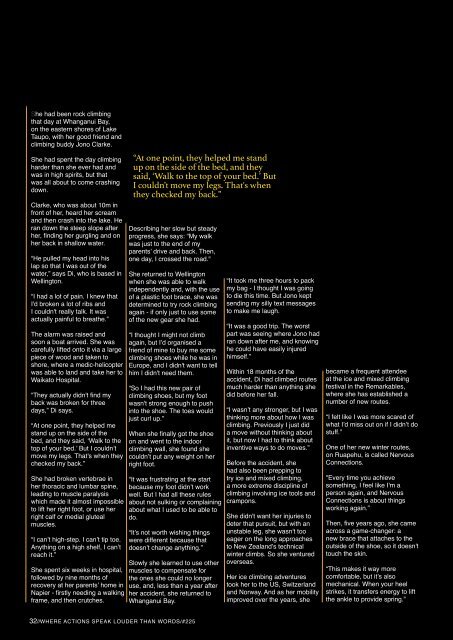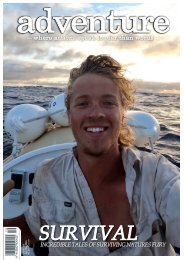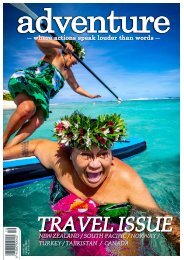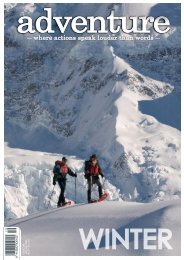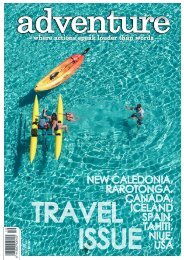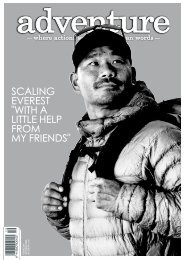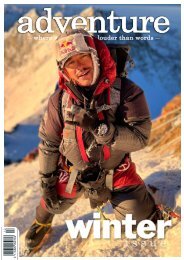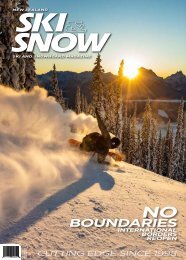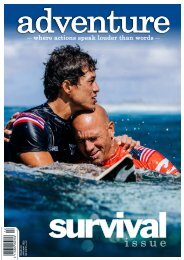Adventure Magazine
Issue 225 Survival Issue
Issue 225 Survival Issue
You also want an ePaper? Increase the reach of your titles
YUMPU automatically turns print PDFs into web optimized ePapers that Google loves.
She had been rock climbing<br />
that day at Whanganui Bay,<br />
on the eastern shores of Lake<br />
Taupo, with her good friend and<br />
climbing buddy Jono Clarke.<br />
She had spent the day climbing<br />
harder than she ever had and<br />
was in high spirits, but that<br />
was all about to come crashing<br />
down.<br />
Clarke, who was about 10m in<br />
front of her, heard her scream<br />
and then crash into the lake. He<br />
ran down the steep slope after<br />
her, finding her gurgling and on<br />
her back in shallow water.<br />
“He pulled my head into his<br />
lap so that I was out of the<br />
water,” says Di, who is based in<br />
Wellington.<br />
“I had a lot of pain. I knew that<br />
I'd broken a lot of ribs and<br />
I couldn't really talk. It was<br />
actually painful to breathe.”<br />
The alarm was raised and<br />
soon a boat arrived. She was<br />
carefully lifted onto it via a large<br />
piece of wood and taken to<br />
shore, where a medic-helicopter<br />
was able to land and take her to<br />
Waikato Hospital.<br />
“They actually didn't find my<br />
back was broken for three<br />
days,” Di says.<br />
“At one point, they helped me<br />
stand up on the side of the<br />
bed, and they said, ‘Walk to the<br />
top of your bed.’ But I couldn’t<br />
move my legs. That's when they<br />
checked my back.”<br />
She had broken vertebrae in<br />
her thoracic and lumbar spine,<br />
leading to muscle paralysis<br />
which made it almost impossible<br />
to lift her right foot, or use her<br />
right calf or medial gluteal<br />
muscles.<br />
“I can’t high-step. I can’t tip toe.<br />
Anything on a high shelf, I can’t<br />
reach it.”<br />
She spent six weeks in hospital,<br />
followed by nine months of<br />
recovery at her parents’ home in<br />
Napier - firstly needing a walking<br />
frame, and then crutches.<br />
“At one point, they helped me stand<br />
up on the side of the bed, and they<br />
said, ‘Walk to the top of your bed.’ But<br />
I couldn’t move my legs. That's when<br />
they checked my back.”<br />
Describing her slow but steady<br />
progress, she says: “My walk<br />
was just to the end of my<br />
parents’ drive and back. Then,<br />
one day, I crossed the road."<br />
She returned to Wellington<br />
when she was able to walk<br />
independently and, with the use<br />
of a plastic foot brace, she was<br />
determined to try rock climbing<br />
again - if only just to use some<br />
of the new gear she had.<br />
“I thought I might not climb<br />
again, but I’d organised a<br />
friend of mine to buy me some<br />
climbing shoes while he was in<br />
Europe, and I didn't want to tell<br />
him I didn't need them.<br />
“So I had this new pair of<br />
climbing shoes, but my foot<br />
wasn't strong enough to push<br />
into the shoe. The toes would<br />
just curl up.”<br />
When she finally got the shoe<br />
on and went to the indoor<br />
climbing wall, she found she<br />
couldn’t put any weight on her<br />
right foot.<br />
“It was frustrating at the start<br />
because my foot didn’t work<br />
well. But I had all these rules<br />
about not sulking or complaining<br />
about what I used to be able to<br />
do.<br />
“It’s not worth wishing things<br />
were different because that<br />
doesn’t change anything.”<br />
Slowly she learned to use other<br />
muscles to compensate for<br />
the ones she could no longer<br />
use, and, less than a year after<br />
her accident, she returned to<br />
Whanganui Bay.<br />
“It took me three hours to pack<br />
my bag - I thought I was going<br />
to die this time. But Jono kept<br />
sending my silly text messages<br />
to make me laugh.<br />
“It was a good trip. The worst<br />
part was seeing where Jono had<br />
ran down after me, and knowing<br />
he could have easily injured<br />
himself.”<br />
Within 18 months of the<br />
accident, Di had climbed routes<br />
much harder than anything she<br />
did before her fall.<br />
“I wasn’t any stronger, but I was<br />
thinking more about how I was<br />
climbing. Previously I just did<br />
a move without thinking about<br />
it, but now I had to think about<br />
inventive ways to do moves.”<br />
Before the accident, she<br />
had also been prepping to<br />
try ice and mixed climbing,<br />
a more extreme discipline of<br />
climbing involving ice tools and<br />
crampons.<br />
She didn't want her injuries to<br />
deter that pursuit, but with an<br />
unstable leg, she wasn't too<br />
eager on the long approaches<br />
to New Zealand’s technical<br />
winter climbs. So she ventured<br />
overseas.<br />
Her ice climbing adventures<br />
took her to the US, Switzerland<br />
and Norway. And as her mobility<br />
improved over the years, she<br />
became a frequent attendee<br />
at the ice and mixed climbing<br />
festival in the Remarkables,<br />
where she has established a<br />
number of new routes.<br />
“I felt like I was more scared of<br />
what I’d miss out on if I didn’t do<br />
stuff.”<br />
One of her new winter routes,<br />
on Ruapehu, is called Nervous<br />
Connections.<br />
"Every time you achieve<br />
something, I feel like I'm a<br />
person again, and Nervous<br />
Connections is about things<br />
working again.”<br />
Then, five years ago, she came<br />
across a game-changer: a<br />
new brace that attaches to the<br />
outside of the shoe, so it doesn't<br />
touch the skin.<br />
“This makes it way more<br />
comfortable, but it’s also<br />
mechanical. When your heel<br />
strikes, it transfers energy to lift<br />
the ankle to provide spring.”<br />
First assent Nervous Connections, Ruapehu<br />
Photo by Jono Clark<br />
"Every time you achieve something,<br />
I feel like I'm a person again, and<br />
Nervous Connections is about things<br />
working again.”<br />
Di's old braces above<br />
made climbing hard.<br />
The new brace (image<br />
right) worked so well<br />
she was even able to<br />
run, completing both<br />
the Rotorua and Boston<br />
Marathons<br />
Di's climbing boot in the Turbomed<br />
Display at OTWorld Leipzeg Germany<br />
First day standing at Waikato Hospital.<br />
Photo by Ian Drayton. July 2004<br />
Running the Boston Marathon<br />
in 2018<br />
Back where it all began: Eternity Road, Whanganui bay<br />
Photo by Steve Minchin<br />
32//WHERE ACTIONS SPEAK LOUDER THAN WORDS/#225<br />
32//WHERE ACTIONS SPEAK LOUDER THAN WORDS/#225


